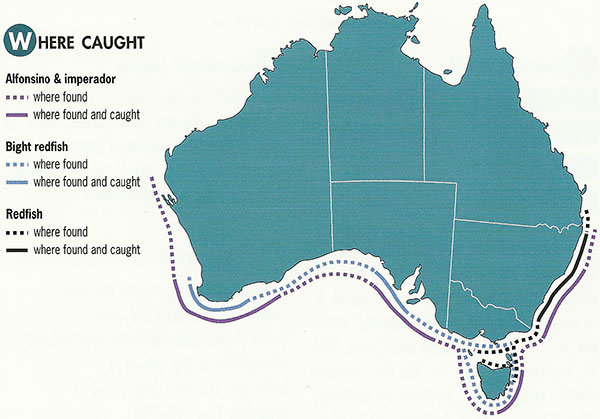Alfonsino is bright red, with a silvery-pink belly a red iris and a deeply forked tail.
Alfonsino has a high oil content and firm white flesh. It can be used in a wide variety of dishes including fish cakes and croquettes.
Catch limits
| Catch limit | Fishing Mortality* | Biomass** |
|---|---|---|
Catch limit 1,017 tonnes For the 2025–26 Season | G;Not subject to overfishing | G;Not overfished |
* Fishing mortality status relates to the level of fishing pressure on a stock - specifically, whether fishing mortality in the year being assessed is likely to result in the stock becoming overfished, or prevent the stock from rebuilding from an overfished state. If fishing mortality exceeds either of these thresholds, a stock is considered to be subject to overfishing.
** Biomass status relates to how many fish there are - specifically, whether the biomass in the year being assessed is above the level at which the risk to the stock is considered to be unacceptable. The HSP defines this level as the limit reference point, below which the stock is considered to be overfished.
Scientific name: Beryx splendens
Family: Berycidae
Other names: Redfish, golden eye perch
Description: A deep-bodied redfish. The upper parts of the head and body, and the base of the fins, are bright orange-red. The sides of the body are silvery pink. The dorsal fin has four close-set spines and 13‑15 soft rays. The anal fin has 3‑4 close-set spines and 25‑29 soft rays. The lower margin of the operculum (the hard bony flap covering the gills) is finely serrated. Alfonsino have large eyes with a blood red iris.
Size (length and weight): Up to 70 cm in length and 4 kg. Usually up to about 40 cm in length.
Life span: Up to about 23 years.
Habitat: Alfonsino are a deepwater species that generally live near the seafloor. Alfonsino are usually found at depths of 200‑400 metres, although they are known to occur down to 1300 metres. Alfonsino tend to aggregate on seamounts. Aggregations are usually associated with rocky/sandy substrates. Juveniles are pelagic.
Prey: Fish, crustaceans and cephalopods.
Predators: Larger bony fish and sharks.
Reproduction: Alfonsino reach reproductive maturity at 5‑8 years old. Spawning occurs during the summer. Females are serial spawners and release eggs 10‑12 times at intervals of about four days during the spawning season. Females produce 270 000‑675 000 eggs per spawning event. Eggs hatch after about 8 days.
| Fishery found in | Gear used | Catch of this species is targeted or incidental |
|---|---|---|
| High Seas | Bottom and midwater trawl | Targeted |
| Southern and Eastern Scalefish and Shark Fishery – East Coast Deepwater Trawl Sector | Bottom and midwater trawl | Targeted |
| Southern and Eastern Scalefish and Shark Fishery – Commonwealth Trawl Sector | Bottom and midwater trawl | Incidental |
| Southern and Eastern Scalefish and Shark Fishery – Gillnet Hook and Trap Sector | Longline | Incidental |
The Commonwealth catch of Alfonsino around the south east of Australia is managed by quota. Which means the catch of this fish by commercial fishers is restricted by weight.
Commercial fishermen are required to fill in records of their catches, during each fishing trip and when they land their catch in a port. This helps us keep records of how much is being caught.
AFMA decide on the amount that can be caught each year from expert advice and recommendations from fisheries managers, industry members, scientist and researchers.
Alfonsino can also be caught in the High Seas area. Australian boats fishing for Alfonsino in this area are limited in much they can catch and where they can fish. They must have a High Seas permit authorised by AFMA.
Alfonsino is a deepwater fish that is known to move further from the bottom at night. It is often found over seamounts and underwater ridges.
The majority of Alfonsino caught by Australian boats are caught in the High Seas and the East Coast Deepwater Zone.

Midwater trawl gear has low impact on habitat because the gear rarely comes in contact with the seabed.
On the High Seas, fishers are restricted to areas that have been fished before. Also, if evidence of vulnerable corals and sponges are found, they must stop fishing and move bottom fishing activities 5 nm away from the area.
Gear
Want to know more?
This is just an overview of alfonsino, if you want to know more see the links below.
This fish is managed under the Southern and Eastern Scalefish and Shark Fishery and under the High Seas permit.
- See the most recent Fishery status report
- Download raw data on annual catches from AFMA catch disposal records and AFMA daily fishing logbooks
- South East Resource Assessment Group
- South East Management Advisory Committee
- Bycatch and discard program
- Visit the FRDC Fishfiles website for the best cooking techniques and recipes for this fish